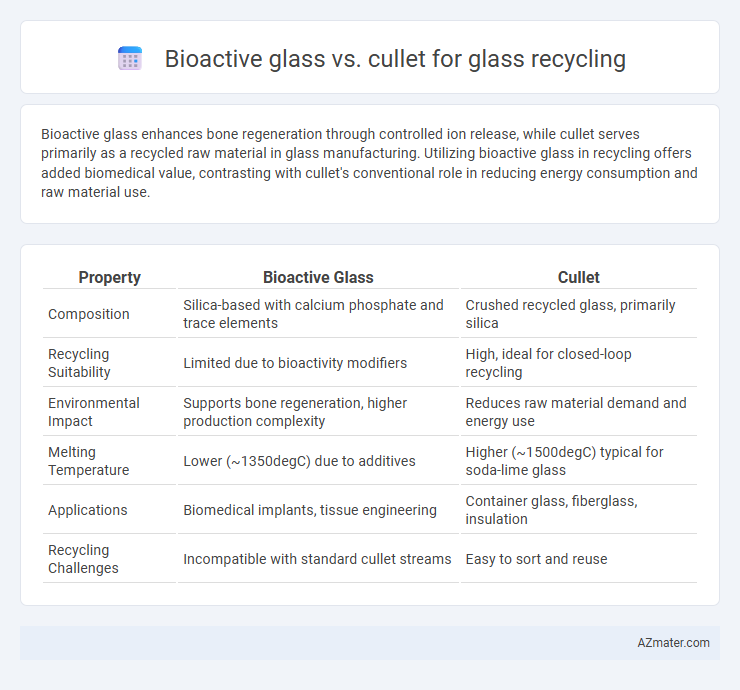Bioactive glass enhances bone regeneration through controlled ion release, while cullet serves primarily as a recycled raw material in glass manufacturing. Utilizing bioactive glass in recycling offers added biomedical value, contrasting with cullet's conventional role in reducing energy consumption and raw material use.
Table of Comparison
| Property | Bioactive Glass | Cullet |
|---|---|---|
| Composition | Silica-based with calcium phosphate and trace elements | Crushed recycled glass, primarily silica |
| Recycling Suitability | Limited due to bioactivity modifiers | High, ideal for closed-loop recycling |
| Environmental Impact | Supports bone regeneration, higher production complexity | Reduces raw material demand and energy use |
| Melting Temperature | Lower (~1350degC) due to additives | Higher (~1500degC) typical for soda-lime glass |
| Applications | Biomedical implants, tissue engineering | Container glass, fiberglass, insulation |
| Recycling Challenges | Incompatible with standard cullet streams | Easy to sort and reuse |
Introduction to Glass Recycling
Glass recycling involves reprocessing cullet, which is crushed glass from waste containers, to create new glass products, reducing raw material use and energy consumption. Bioactive glass, unlike traditional cullet, is engineered for medical applications and contains specific compositions such as calcium phosphates that promote bone regeneration, making it less suitable for conventional glass recycling processes. The key distinction lies in the chemical properties and intended use, with cullet primarily targeting environmental sustainability in manufacturing, while bioactive glass focuses on biomedical functionality.
What is Bioactive Glass?
Bioactive glass is a type of biocompatible silica-based material known for its ability to bond with bone and stimulate tissue regeneration, making it highly valuable in medical and dental applications. Unlike cullet, which is primarily recycled glass used as raw material in manufacturing, bioactive glass contains specific oxides such as calcium oxide, phosphorus pentoxide, and sodium oxide that enable its unique biological activity. Its incorporation into recycling processes requires careful separation from conventional cullet to maintain the functional properties essential for biomedical use.
Understanding Cullet in Glass Recycling
Cullet is crushed recycled glass used as a raw material in glass manufacturing, offering significant energy savings and reducing the need for virgin materials. Its high silica content promotes efficient melting, making it a sustainable alternative to traditional raw materials like sand and soda ash. Understanding cullet's role enhances glass recycling processes by improving raw material efficiency and lowering carbon emissions.
Composition Differences: Bioactive Glass vs Cullet
Bioactive glass primarily consists of silica (SiO2), calcium oxide (CaO), sodium oxide (Na2O), and phosphorus pentoxide (P2O5), designed to interact biologically by releasing ions that promote bone regeneration. Cullet, or recycled glass, typically contains a broader mix of silica with varying amounts of metal oxides, including iron oxide (Fe2O3), aluminum oxide (Al2O3), and other contaminants depending on the source and color of the recycled material. The key difference lies in bioactive glass's controlled composition tailored for medical applications, while cullet's composition is less uniform and optimized for remelting into new glass products.
Processing Techniques: Bioactive Glass vs Traditional Cullet
Bioactive glass requires specialized processing techniques involving controlled melting and precise thermal treatments to maintain its unique biocompatible properties, whereas traditional cullet recycling relies on standard crushing, cleaning, and remelting processes optimized for soda-lime glass. The incorporation of bioactive glass into recycling streams demands advanced filtration and contamination control to preserve its functionality, contrasting with cullet recycling, which primarily focuses on cost-efficient energy consumption and raw material recovery. Processing bioactive glass separately enhances the efficiency of recycling for biomedical applications, while traditional cullet processing prioritizes large-scale glass container and window glass production.
Environmental Impact Comparison
Bioactive glass offers superior environmental benefits compared to cullet in glass recycling due to its enhanced bioactivity, which promotes tissue regeneration and reduces waste toxicity. Unlike conventional cullet, bioactive glass can be broken down more efficiently during recycling processes, minimizing landfill accumulation and lowering energy consumption. The use of bioactive glass in recycling significantly diminishes carbon emissions and supports sustainable waste management practices by enabling high-value material recovery.
Efficiency in Glass Manufacturing
Bioactive glass exhibits higher efficiency in glass manufacturing due to its enhanced reactivity and lower melting temperature, leading to reduced energy consumption compared to cullet. Cullet, while commonly used as a recycled material, often requires higher processing energy to achieve desired purity and consistency in new glass products. Incorporating bioactive glass into the recycling process optimizes raw material utilization and improves overall manufacturing throughput.
Applications Beyond Traditional Recycling
Bioactive glass offers unique bioactive properties, making it ideal for medical and dental applications such as bone regeneration and wound healing, unlike cullet which is primarily recycled for manufacturing new glass products. Cullet, composed of crushed recycled glass, is essential in traditional glass recycling processes for creating containers and fiberglass but lacks the functional benefits of bioactive glass in biomedical fields. Advanced recycling of bioactive glass enables sustainable production of high-performance biomaterials, expanding applications beyond conventional glass recycling into healthcare and tissue engineering.
Challenges in Integration and Compatibility
Bioactive glass presents significant challenges in recycling streams due to its unique chemical composition, which often includes therapeutic ions that can interfere with standard cullet processing. Its lower melting temperature compared to traditional cullet creates compatibility issues in melting furnaces, leading to phase separation and defects in recycled glass products. The integration of bioactive glass into cullet recycling requires careful adjustment of furnace parameters and segregation strategies to maintain product quality and process efficiency.
Future Trends and Innovations in Glass Recycling
Bioactive glass recycling is poised to benefit from advancements in selective separation technologies and material-specific recycling processes that enhance purity and functionality in secondary raw materials. Innovations in sensor-based sorting and chemical treatments enable efficient recovery of high-value bioactive glass components, contrasting with traditional cullet recycling which focuses primarily on bulk melt reuse. Emerging trends include the integration of bioactive glass waste into novel composite materials and circular economy frameworks, driving sustainability and higher-performance applications in medical and environmental sectors.

Infographic: Bioactive glass vs Cullet for Glass recycling
 azmater.com
azmater.com